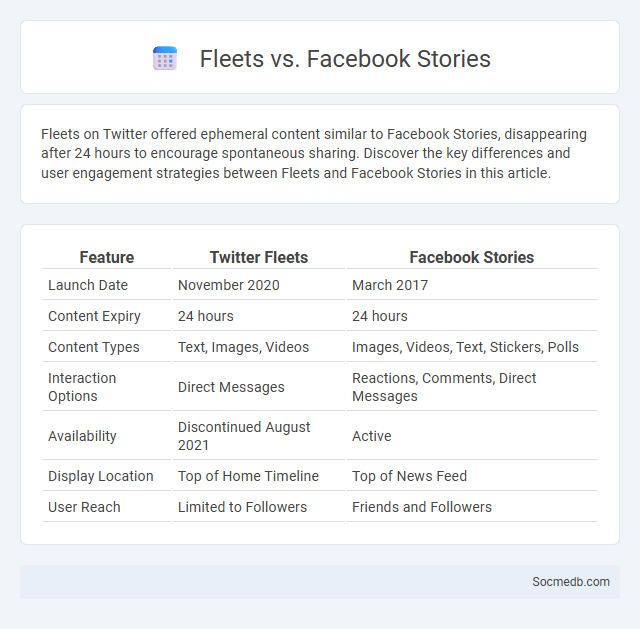
Photo illustration: Fleets vs Facebook Stories
Fleets on Twitter offered ephemeral content similar to Facebook Stories, disappearing after 24 hours to encourage spontaneous sharing. Discover the key differences and user engagement strategies between Fleets and Facebook Stories in this article.
Table of Comparison
| Feature | Twitter Fleets | Facebook Stories |
|---|---|---|
| Launch Date | November 2020 | March 2017 |
| Content Expiry | 24 hours | 24 hours |
| Content Types | Text, Images, Videos | Images, Videos, Text, Stickers, Polls |
| Interaction Options | Direct Messages | Reactions, Comments, Direct Messages |
| Availability | Discontinued August 2021 | Active |
| Display Location | Top of Home Timeline | Top of News Feed |
| User Reach | Limited to Followers | Friends and Followers |
Understanding Fleets and Facebook Stories
Fleets on Twitter and Facebook Stories are temporary posts designed to share moments that disappear after 24 hours, increasing content authenticity and spontaneity. Your engagement with Fleets and Facebook Stories can enhance real-time interaction through features like stickers, polls, and direct messaging, fostering a sense of immediacy and connection. Optimizing your social media strategy by utilizing these ephemeral formats boosts visibility and audience engagement on these platforms.
Key Features of Fleets
Fleets on social media offer ephemeral content that disappears after 24 hours, encouraging more spontaneous and less polished sharing. These temporary posts include text, photos, videos, and interactive stickers, providing your audience with engaging, fleeting updates. You can enhance visibility and foster real-time conversations by leveraging Fleets' seamless integration with direct messaging and reactions.
Key Features of Facebook Stories
Facebook Stories offer a dynamic way for you to share photos and videos that disappear after 24 hours, ensuring timely and engaging content. Key features include interactive stickers, polls, and augmented reality effects that boost audience interaction and personalize your posts. These stories also provide insights on viewer engagement, helping you analyze the impact and optimize future content.
User Experience Comparison
User experience on social media platforms varies significantly based on interface design, content relevance, and engagement algorithms. You can enjoy personalized feeds on platforms like Instagram and TikTok, while Facebook offers comprehensive networking tools but may have a more cluttered interface. Prioritizing seamless navigation and meaningful interactions enhances overall satisfaction across social media apps.
Audience Reach and Engagement
Social media platforms enable brands to expand their audience reach by targeting specific demographics using advanced algorithms. High engagement rates, measured through likes, shares, and comments, provide valuable insights into content effectiveness and audience preferences. Leveraging data analytics helps optimize posting schedules and tailor content to boost interaction and brand visibility.
Privacy and Control Options
Social media platforms provide various privacy and control options to protect your personal information and manage who can view your content. Features such as custom audience settings, two-factor authentication, and activity logs enable users to secure their accounts and monitor access effectively. Regularly updating these settings enhances your online safety and minimizes risks of unauthorized data exposure.
Content Creation Tools
Content creation tools for social media encompass a wide array of software designed to streamline the production of visually appealing graphics, videos, and posts, enhancing user engagement and brand visibility. Platforms like Canva, Adobe Spark, and InShot provide intuitive interfaces that empower creators to design custom content with templates, filters, and editing features optimized for platforms such as Instagram, TikTok, and Facebook. Leveraging AI-powered tools like Lumen5 and Copy.ai accelerates content generation by automating video editing and caption writing, ensuring consistent output that aligns with trending keywords and audience preferences.
Lifespan and Visibility
Social media content lifespan varies widely by platform, with posts on Twitter often visible for just minutes, while content on Facebook or Instagram can remain relevant for days or weeks. Visibility is heavily influenced by engagement metrics such as likes, shares, and comments, which boost algorithmic prioritization in users' feeds. Strategic timing and content quality are crucial to maximizing both lifespan and visibility across different social media channels.
Platform Integration and Ecosystem
Social media platform integration enhances user experience by enabling seamless content sharing, messaging, and cross-platform activity synchronization. Major ecosystems like Facebook, Instagram, and WhatsApp under Meta utilize shared APIs and unified login systems to boost engagement and data connectivity. This interconnected setup drives increased user retention and provides businesses with comprehensive analytics across multiple channels.
Which is Best for Your Social Media Strategy?
Choosing the best social media platform for your strategy depends on your target audience, content type, and marketing goals. Platforms like Facebook offer vast user reach, Instagram excels in visual content engagement, TikTok caters to short, viral videos, and LinkedIn suits B2B connections and professional networking. Understanding where your audience spends time and how they interact with content helps you maximize your social media impact effectively.
 socmedb.com
socmedb.com